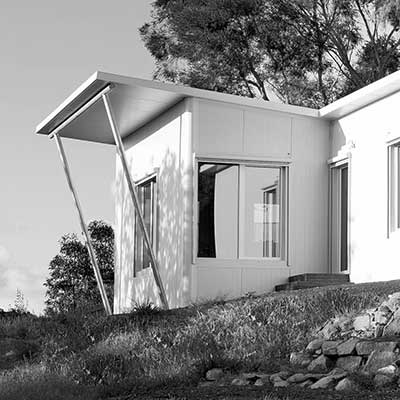
Australia has a star rating system, administered by the Federal Government, known as NatHERS. Stars sound very clear and positive. However, there is a bit of confusion about the star ratings produced by NatHERS.
Importantly, NatHERS assumes something that is virtually never tested.The NatHERS scheme has the long title “Nationwide House Energy Rating Scheme” and its website is administered by the Department of Industry, Innovation and Science.
Many people will know that 6 stars is the minimum requirement for new houses, and that 10 stars is amazing. In fact, the government website says that “occupants of a 10 star rated home are unlikely to need any artificial cooling or heating.”
I’m not sure about that. In any event, 10 stars is supposed to be better than 6 stars.
NatHERS has a software program that takes into account a number of things that will affect the thermal performance of a building (how comfortable it is inside and how much energy is used to achieve that comfort).
It is a fairly rudimentary program compared to some other international software packages. It produces a very short report.
It also assumes things that are not tested by law.
One of the very important assumptions that is made in this scheme is how airtight the building is.
Airtightness is important, together with other elements of good design, so that you can keep a stable temperature inside your home without excessive heating or cooling systems. It’s important so that uncomfortably hot air or cold air are kept out.
While some people are frightened by the term “airtightness” (because they think it will be claustrophobic, or will encourage mould growth), airtightness is crucial for building performance along with proper systems for ventilation including openable windows.
For human comfort and health, ventilation needs to be controlled, temperatures need to be controlled, and fresh air needs to be maintained – all at the same time.
This means that it’s just not good enough in many parts of Australia to have buildings that are wind tunnels.
In Melbourne, for example, we need to keep warm for much of the year. This means we need to keep the cold out of our buildings for well over half of the year. In the same way that we as humans go outside with socks, shoes, and coats to protect us from the cold wind, an airtight seal helps to protect our buildings from the cold outside our building envelope.
It is actually the same concept when it’s hot outside. A well-designed, well-sealed building can keep people cooler inside and keep the heat out as well.
I was shocked when I first saw the level of detail that goes into building physics calculations of a certified passive house. Some 30 pages of spreadsheets are produced by the International program called the “PHPP” (passive house planning package).
NatHERS has a more basic calculation method than the PHPP. This is evident by the report it produces.
Accordingly, one just can’t compare a sophisticated modelling tool like the PHPP with a much more primitive one.
So don’t be impressed if a passive house comes out as 9 stars on NatHERS, because a very poorly performing building can also be given 9 stars on such a basic tool. It is like doing a primary school test for English vs a university level exam. It is easy for a university student to get 10/10 for a grade 4 English test. The primary school test just doesn’t assess higher level standards.
Leaving aside complexity differences, there is one crucial difference between a NatHERS assessment and a PHPP one: airtightness.
The thermal efficiency results produced by the PHPP modelling program depend on one crucial final test of any compliant passive house building: it has to be very well sealed. It has to pass a stringent pressure test called a “blower door test.”
Airtightness is something that can be tested quickly and easily on a physical building: you do a test, you get a result. Yes, you can do slightly different types of tests, but they will give you some result of how much air is leaking from the building.
A recent CSIRO report highlighted this issue by giving us real assessments of the airtightness of buildings in Australia: the Housing Energy Efficiency Inspections Report from December 2015. According to this report, 15 air changes per hour at a pressure of 50 pascals is assumed by NatHERS for its rating calculations. For short, this is described as 15 ACH@50Pa, or simply 15.
This report mainly reviewed a small number of houses around the country which were less than three years old – so they would have to be 6 star houses as a minimum, because that is our current mandatory standard.
The testing of the Melbourne houses is not really a comparable result because the houses were up to 10 years old and a 4 and 5 star standard.
Also, the number tested overall was quite small, and based on volunteers, which would skew the figures in terms of national averages. The writers make the comment that some of the volunteers had bespoke, high quality builds, making them perhaps more likely to be well-sealed.
To contrast the energy efficiency modelled by NatHERS with that modelled by the International Passive House Institute, it is interesting to look at the different airtightness approaches.
The Passive House Standard requires a 0.6.
NatHERS assumes 15.
That means the NatHERS house assumption is 25 times as leaky as the Passive House Standard requirement.
Put another way, the Certified Passive House is over 25 times better sealed than that assumed by NatHERS.
What did the Australian homes who volunteered for the CSIRO report achieve on this sort of test?
Averages reported were: Canberra 14, Hobart 8, Perth 25, Sydney 21, Adelaide 9, Brisbane 11, Melbourne 20. All houses averaged 15.4.
But averages (and medians) can be misleading. Many of the houses tested blew more than 15. The graphs in the report are not highly detailed, but it seems as though over more than half of the houses blew higher than 15.
A key point that can be made is that your energy rating assumes an airtightness result after construction that is quite likely not to be correct, or perhaps as likely as not to be incorrect. You won’t know.
So when you say “I bought a 6 star house” what does it really mean? If your building leaks, it is not the star rating predicted.
And how do you get a good result on your next building? The CSIRO report says at page 11 “General build quality and attention to detail seem to be significant factors…Houses with uPVC window frames recorded much lower air change rates than most other houses.”
But how do you know your building is airtight?
There’s only one way to know, and that’s to get it tested.
The report recommends that there should be “specific air tightness requirements in the NCC,” but that ensuring compliance could involve “a random selection of newly built houses” being tested. Further, “NatHERS could allow high performing houses to receive higher star ratings by incorporating certified air pressure results into NatHERS calculations. Currently, houses that have achieved good air infiltration results get no star rating benefit from this.”
Next time you commission a new house, you might like to consider instructing the builder to get a blower door test done. Even better, ask for a specific result to be achieved. Why stop at 15? Ask for 10, five, or maybe even the passivhaus standard of 0.6.
That is likely to make your house better, assuming that all other design elements like ventilation, orientation, windows, insulation and thermal bridges have also been given some attention, as they are given attention for the Passive House Standard.
And on the other hand, if certified Passive Houses had all their benefits calculated properly on NatHERS, including the blower door test result, could we be looking at 15 or 20 star houses?
Now that would be literally “off the scale.”





